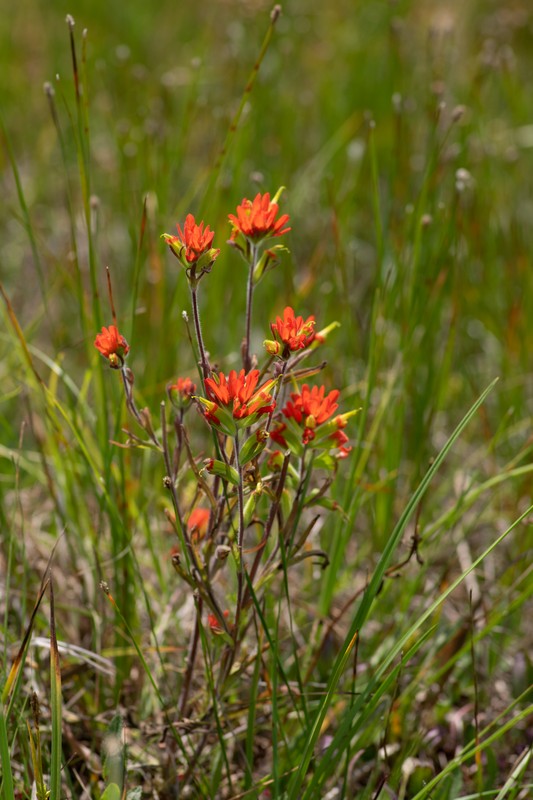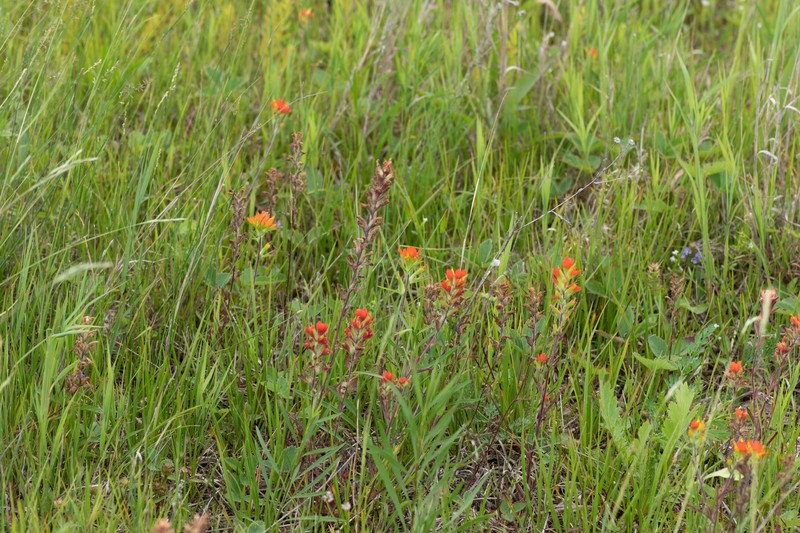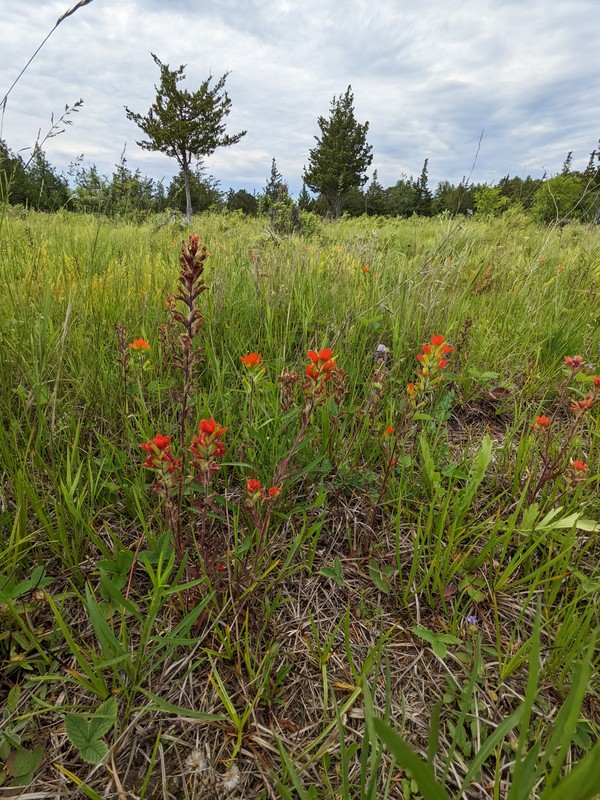Indian Paintbrush
Castilleja coccinea (L.) Spreng.
- Class
- Dicotyledoneae (Dicots)
- Family
- Orobanchaceae (Broom-Rape Family)
- State Protection
- Endangered
Listed as Endangered by New York State: in imminent danger of extirpation in New York. For animals, taking, importation, transportation, or possession is prohibited, except under license or permit. For plants, removal or damage without the consent of the landowner is prohibited.
- Federal Protection
- Not Listed
- State Conservation Status Rank
- S1
Critically Imperiled in New York - Especially vulnerable to disappearing from New York due to extreme rarity or other factors; typically 5 or fewer populations or locations in New York, very few individuals, very restricted range, very few remaining acres (or miles of stream), and/or very steep declines.
- Global Conservation Status Rank
- G5
Secure globally - Common in the world; widespread and abundant (but may be rare in some parts of its range).
Summary
Did you know?
Castilleja coccinea was first described as a new species in 1737 by Linnaeus who placed it in the genus Bartsia. It was later transferred to the genus Euchroma in 1818 and finally to the genus Castilleja in 1825. The genus Castilleja was named for Domingo Castillejo, Spanish botanist and Professor of Botany in Cadiz, Spain, in 1782 by Jose Celestino Mutis in Linnaeus' son's book Supplementum Plantarum. The moving around does not stop there as the genus Castilleja has recently been transferred with other hemiparasitic members of the family Scrophulariaceae into the family Orobanchaceae. Even though it may be difficult to grow because of its need for certain host plants the seeds are available through various wildflower nurseries.
State Ranking Justification
There are two large and three small populations and all of them are threatened in the long term by invasive species and habitat succession. There are 20-30 historical occurrences mostly from the 1880s through the 1920s.
Short-term Trends
At the two large sites in the state the plants are remaining stable. The three smaller sites have not been resurveyed and their status is unknown.
Long-term Trends
This species was most common in New York from the 1880s through the 1920s when there was much more open prairie-like habitat that has since regrown to forest or has been developed and farmed. The populations have declined substantially since then and will likely remain in low numbers.
Conservation and Management
Threats
There are no immediate threats to the larger populations but in the long term the invasive black swallowwort may threaten their open limestone habitats. The small populations in Dutchess County and St. Lawrence County may be threatened by succession of their open habitats or by destruction by ATVs.
Conservation Strategies and Management Practices
Prevent the invasion of black swallowwort.
Research Needs
Research could be done into the feasibility of augmenting existing populations.
Habitat
Habitat
In New York Scarlet Indian-paintbrush is found on open, usually calcareous sites, including on limestone bedrock in alvar grasslands, an old field at the edge of a fen, and a mowed right-of-way on a sandy logging road (New York Natural Heritage Program 2007). A rare native on the barrens of the northern Lake Plains only; also escaping cultivation widely elsewhere in NY (Mitchell and Tucker 1997). Meadows, moist prairies, and damp sandy soil (Gleason and Cronquist 1991). Peaty meadows, prairies and damp sands and gravels (Fernald 1970).
Associated Ecological Communities
- Alvar pavement grassland
(guide)
This community consists of exposed, flat limestone or dolostone pavement with grassy or mossy patches interspersed throughout. Some examples may be solely grassland with no pavement.
- Alvar shrubland*
(guide)
A shrub-dominated community that has over 25% cover of tall, short, and dwarf shrubs. There are often deep crevices or grikes in the limestone pavement; trees and shrubs are often rooted in the grikes.
- Alvar woodland*
(guide)
A subset of the limestone woodland community restricted to the alvar region in Jefferson County, New York.
- Rich graminoid fen*
(guide)
A wetland of mostly grasses usually fed by water from highly calcareous springs or seepage. These waters have high concentrations of minerals and high pH values, generally from 6.0 to 7.8. Plant remains do not decompose rapidly and these grasses usually grow on older, undecomposed plant parts.
- Sedge meadow*
(guide)
A wet meadow community that has organic soils (muck or fibrous peat). Soils are permanently saturated and seasonally flooded. The dominant herbs must be members of the sedge family, typically of the genus Carex.
* probable association but not confirmed.
Associated Species
- Apocynum androsaemifolium (spreading dogbane)
- Carex flava (yellow sedge)
- Danthonia spicata (poverty grass)
- Fragaria virginiana
- Oligoneuron album
- Pteridium aquilinum
- Spiraea tomentosa (steeplebush)
- Symphyotrichum pt
- Toxicodendron radicans
- Trifolium pratense (red clover)
Range
New York State Distribution
In New York this species is found in Western New York on the Lake Erie and Lake Ontario Plains, as well as in the Lower Hudson Valley.
Global Distribution
Scarlet Indian-paintbrush is known from Nova Scotia and Maine in the northeast, west as far as Saskatchewan and Minnesota, and through all the southern states to Florida, reaching its western limits in Louisiana, Oklahoma, and Kansas.
Identification Comments
General Description
This species is an annual or biennial wildflower with short (20-60cm) finely hairy stems. The common name refers to the flower bracts, which look as if they were dipped in scarlet paint, and are divided into 3 to 5 scarlet-tipped lobes. The actual flowers are a much less conspicuous pale yellow, 17-25mm long, and often at least partially obscured by the scarlet bracts and calyx.
Best Life Stage for Proper Identification
Stems with flowers or fruits are best for identification, though since many populations are small it is better to take a photograph than a specimen.
Similar Species
There are no other species of Castilleja in the state, and our species is distinctive. However, some populations may represent escapes from garden cultivation or roadside seed mixes.
Best Time to See
This species may display its conspicuous red flowers from May through July; fruits persist through the summer.
- Flowering
- Fruiting
The time of year you would expect to find Indian Paintbrush flowering and fruiting in New York.
Indian Paintbrush Images
Taxonomy
Indian Paintbrush
Castilleja coccinea (L.) Spreng.
- Kingdom Plantae
- Phylum Anthophyta
- Class Dicotyledoneae
(Dicots)
- Order Scrophulariales
- Family Orobanchaceae (Broom-Rape Family)
- Order Scrophulariales
- Class Dicotyledoneae
(Dicots)
- Phylum Anthophyta
Additional Common Names
- Indian-paintbrush
- Painted Cup
- Scarlet Indian-paintbrush
- Scarlet Paintbrush
Additional Resources
References
Clemants, Steven and Carol Gracie. 2006. Wildflowers in the Field and Forest. A Field Guide to the Northeastern United States. Oxford University Press, New York, NY. 445 pp.
Fernald, M.L. 1950. Gray's manual of botany. 8th edition. D. Van Nostrand, New York. 1632 pp.
Gleason, Henry A. and A. Cronquist. 1991. Manual of Vascular Plants of Northeastern United States and Adjacent Canada. The New York Botanical Garden, Bronx, New York. 910 pp.
Holmgren, Noel. 1998. The Illustrated Companion to Gleason and Cronquist's Manual. Illustrations of the Vascular Plants of Northeastern United States and Adjacent Canada. The New York Botanical Garden, Bronx, New York.
New York Natural Heritage Program. 2010. Biotics database. New York Natural Heritage Program. New York State Department of Environmental Conservation. Albany, NY.
New York Natural Heritage Program. 2024. New York Natural Heritage Program Databases. Albany, NY.
Newcomb, Lawrence. 1977. Newcomb's Wildflower Guide: An Ingenious New Key System for Quick, Positive Field Identification of the Wildflowers, Flowering Shrubs, and Vines of Northeastern and North-Central North America. Little, Brown and Company. Boston.
Reschke, Carol. 1990. Ecological communities of New York State. New York Natural Heritage Program, New York State Department of Environmental Conservation. Latham, NY. 96 pp. plus xi.
Rhoads, Ann F. and Timothy A. Block. 2000. The Plants of Pennsylvania, an Illustrated Manual. University of Pennsylvania Press, Philadelphia, PA.
Voss, Edward G. 1996. Michigan Flora Part III. Dicots Concluded (Pyrolaceae - Compositae). Cranbrook Institute of Science Bulletin 61 and University of Michigan Herbarium. 622 pp.
Weldy, T. and D. Werier. 2010. New York flora atlas. [S.M. Landry, K.N. Campbell, and L.D. Mabe (original application development), Florida Center for Community Design and Research http://www.fccdr.usf.edu/. University of South Florida http://www.usf.edu/]. New York Flora Association http://newyork.plantatlas.usf.edu/, Albany, New York
Weldy, Troy W. and David Werier. 2005. New York Flora Atlas. [S.M. Landry, K.N. Campbell, and L.D. Mabe (original application development), Florida Center for Community Design and Research. University of South Florida]. New York Flora Association, Albany, NY. Available on the web at (http://newyork.plantatlas.usf.edu/).
Links
About This Guide
Information for this guide was last updated on: February 1, 2023
Please cite this page as:
New York Natural Heritage Program. 2024.
Online Conservation Guide for
Castilleja coccinea.
Available from: https://guides.nynhp.org/scarlet-indian-paintbrush/.
Accessed July 26, 2024.



